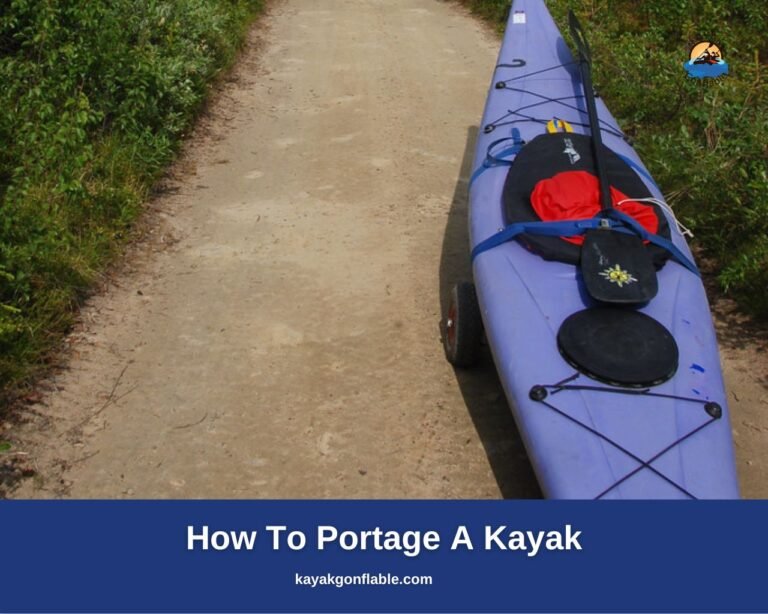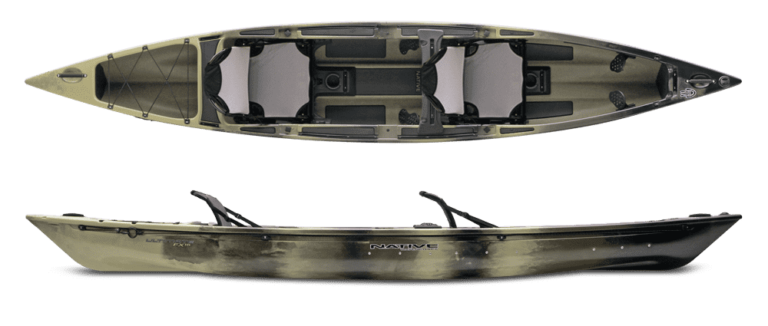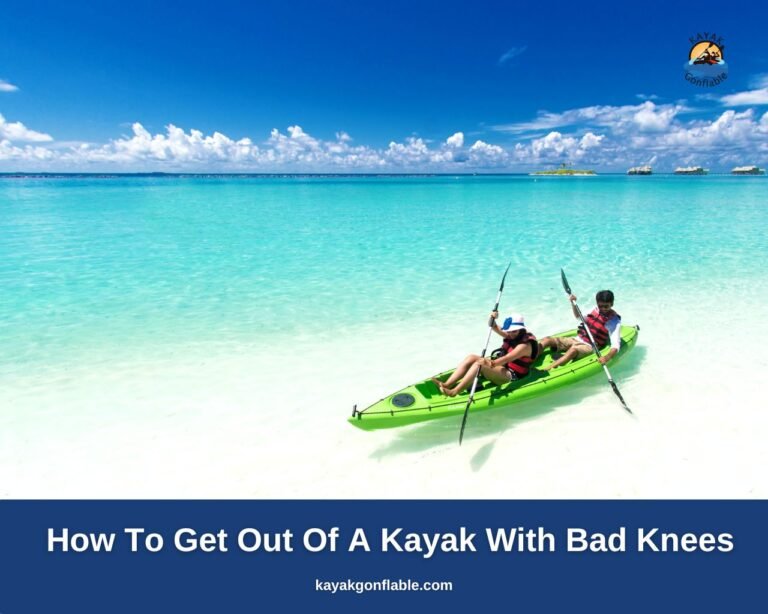Best Kayaking Accessories: A Detailed Guide
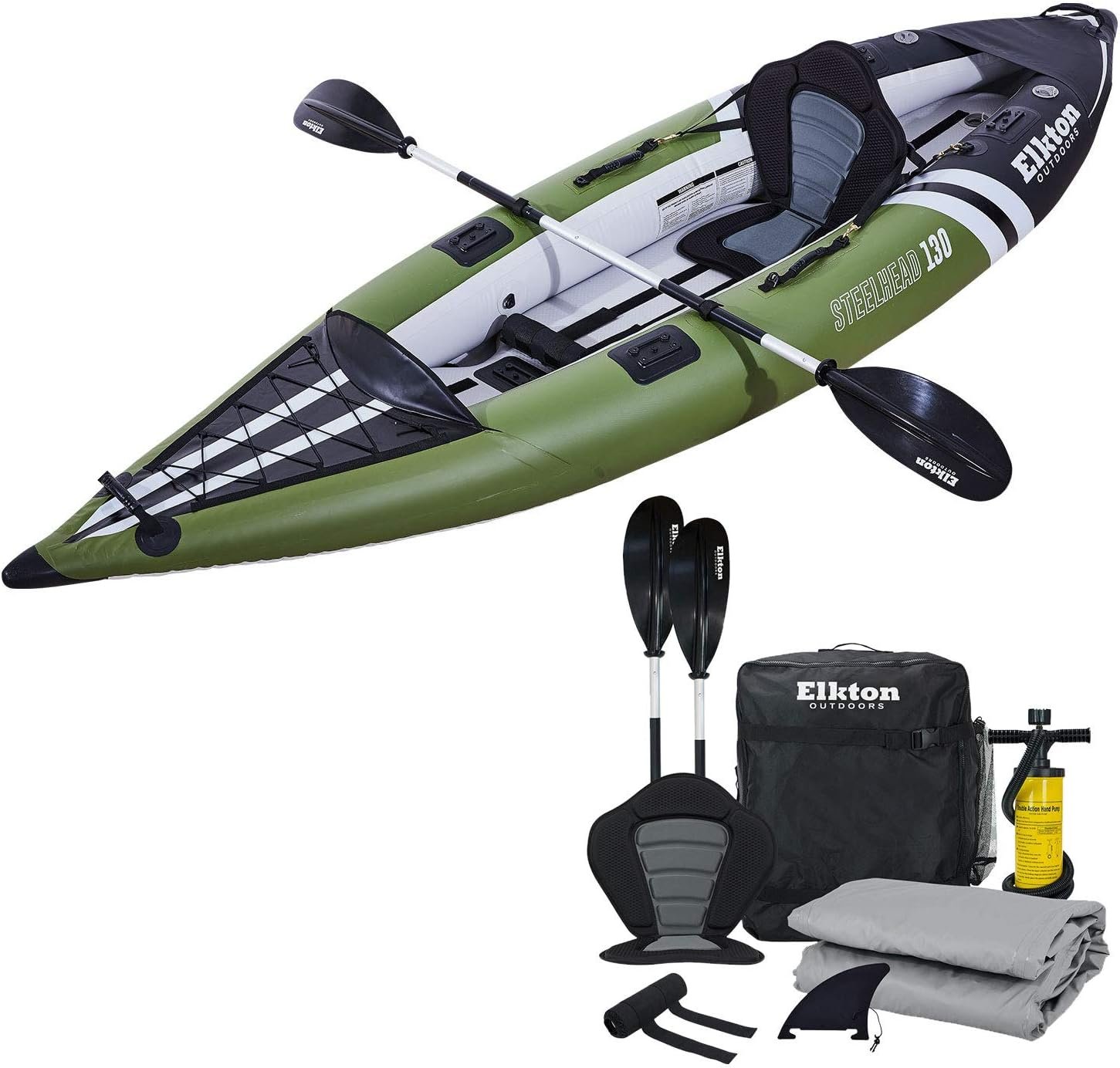
Do You Really Need Kayak Accessories?
Kayaking is a thrilling watersport that allows enthusiasts to explore lakes, meander rivers, and paddle through rugged coastlines. While the kayak itself is the vessel that propels us through these waterways, it’s the kayaking accessories that truly improve our experiences.
These essential add-ons play an important role in enhancing safety, comfort, and performance during kayaking adventures.
Kayaking Safety Accessories
As usual, safety should always be paramount when going on a kayaking trip. Proper accessories can be your lifeline in challenging conditions. Here’s how they contribute to your safety:
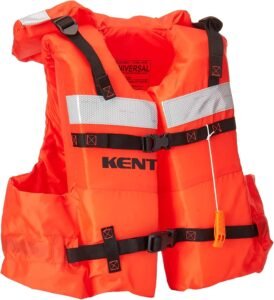
PFDs (Personal Flotation Devices)
A PFD is not just a legal requirement; it’s a lifesaver. It keeps you afloat in case of an unexpected capsize, ensuring you stay above water. Many PFDs come with a built-in whistle, allowing you to signal for help if needed.
Different Types of PFDs
There are several types to choose from, each designed for specific conditions:
- Type I PFDs: These are best suited for open, rough waters, as they provide the most buoyancy and can turn an unconscious user face up. They are bulkier but extremely reliable for emergencies.
- Type II PFDs: Typically used for calm, inland waters, these PFDs provide good buoyancy but may not turn an unconscious user face up as reliably as a Type I PFD. They are less bulky and more comfortable for extended wear.
- Type III PFDs: Ideal for kayaking, these PFDs are comfortable and designed for water sports. They provide good buoyancy and freedom of movement. They are not suitable for unconscious wearers as they may not turn their faces up.
- Type IV PFDs: These are throwable devices, such as ring buoys or seat cushions, meant to be kept on board for rescue situations. They are not meant to be worn.
- Type V PFDs: These are specialized PFDs designed for specific activities. They offer various features tailored to the sport, such as extra pockets and attachment points.
Some Key Things To Look For In Your PFDs
- Fit: Ensure your PFD fits snugly but comfortably, with all straps secured. A loose PFD can ride up and impede your movements.
- Buoyancy: Choose a PFD with adequate buoyancy for your body weight. The label on the PFD should specify its buoyancy rating.
- Features: Look for features like adjustable straps, pockets for storing safety essentials, and reflective tape for visibility in low light.
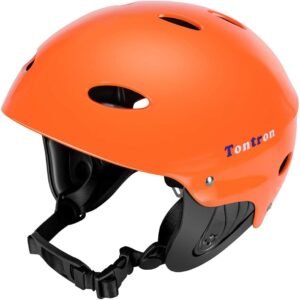
Helmets
For whitewater kayaking, a sturdy helmet protects your head from potential collisions with rocks and other obstacles. The last thing you want is to become unconscious while kayaking.
Why Helmets Are Necessary for Whitewater Kayaking
Whitewater kayaking involves navigating turbulent and rocky rapids, making your head protection essential.
- Head Impact Protection: In the event of a capsize or collision with rocks, a kayak helmet protects your head from potentially severe injuries.
- Confidence and Focus: Knowing you’re protected allows you to concentrate on your paddling technique rather than worrying about potential hazards.
What To Look For When Selecting A Kayaking Helmet
- Material: Helmets are typically constructed from durable materials like ABS plastic or fiberglass. Ensure the helmet is CE or ANSI-certified for safety.
- Ventilation: Adequate ventilation prevents overheating during strenuous paddling.
- Fit: The helmet should fit snugly without being too tight. It should not shift when you move your head.
- Visor: Some helmets come with visors that shield your eyes from sun and water splashes.
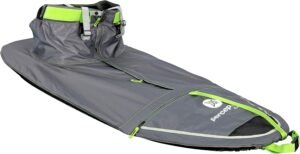
Spray Skirts
These keep water out of your kayak, preventing it from filling up and capsizing.
Safety Whistles
Safety whistles are a vital tool for communication and alerting others in case of emergencies while kayaking. Here are some important reasons to get safety whistles:
- Audibility: A loud whistle can be heard over the sound of wind and waves, allowing you to signal for help in remote areas.
- Distress Signal: Whistles are internationally recognized distress signals, making them valuable in urgent situations.
Choosing a Suitable Safety Whistle
- Decibels: Look for a whistle that produces at least 100 decibels for maximum audibility.
- Material: Opt for a corrosion-resistant material like plastic or aluminum, as it will endure repeated exposure to water.
- Attachment: Ensure the whistle has a secure attachment mechanism, like a clip or lanyard, to keep it accessible.
Apparel Accessories
Kayaking Gloves
Benefits of Using Gloves
- Grip and Control: Gloves provide a better grip on your paddle, especially when your hands are wet, preventing slips and ensuring efficient strokes.
- Hand Protection: They protect your hands from blisters, abrasions, and the sun’s harmful UV rays.
- Warmth: In cooler conditions, paddling gloves provide an extra layer of insulation, keeping your hands warm and comfortable.
Types of Styles & Materials Kayaking Gloves Are Made of
- Neoprene Gloves: These are ideal for cold water kayaking, offering excellent insulation and water resistance.
- Fingerless Gloves: These provide a compromise between grip and dexterity while still offering some hand protection.
- Full-Finger Gloves: For added warmth and protection, full-finger gloves are suitable for colder conditions.
- Sun Gloves: Designed for sun protection, these lightweight gloves shield your hands from harmful UV rays.
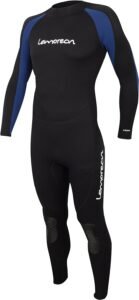
Neoprene Wetsuits and Drysuits
Difference Between Wetsuits and Drysuits
- Wetsuits: Made from thick neoprene, wetsuits are designed to trap a thin layer of water between your body and the suit. Your body heat warms this water, providing insulation in cold conditions. They are suitable for moderately cold water but allow some water to enter the suit.
- Drysuits: Drysuits are completely waterproof and do not allow water to enter. They are ideal for extremely cold water or situations where you need to stay completely dry.
When to Use Each Type of Suit and Their Thermal Properties
Wetsuits: Use wetsuits in cooler but not freezing water temperatures. They offer thermal protection while allowing for some water exchange to regulate your body temperature.
Drysuits: Choose a dry suit in frigid conditions where you must stay completely dry. They are commonly used in icy waters and for activities like sea kayaking or kayak fishing in cold climates. Drysuits are typically warmer due to their complete waterproofing, while wetsuits are more versatile for varying water temperatures.
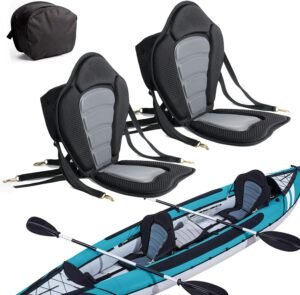
Kayak Seats and Cushions
- Reduced Fatigue: Properly designed kayak seats and cushions reduce pressure points, preventing discomfort and fatigue during long kayaking sessions.
- Improved Posture: Ergonomically designed seats promote better posture, reducing the risk of back pain.
- Enhanced Control: Comfortable seating allows you to maintain better control of your kayak, improving your overall performance.
Various Seat Options and Cushion Materials
- Molded Seats: These are integrated into the kayak’s design and provide excellent support but may not be adjustable.
- Padded Seats: Often detachable, padded seats offer extra cushioning and are adjustable for a customized fit.
- Inflatable Seats: These lightweight options provide adjustable firmness and are easy to transport.
- Gel Seat Cushions: Gel-filled cushions distribute your weight evenly and provide exceptional comfort.
- Foam Seat Cushions: Foam cushions are affordable and provide adequate comfort for short paddling trips.
When selecting a seat or cushion, consider your comfort needs and the type of kayaking you plan to do. Longer trips may benefit from more advanced seating options, while shorter outings may be comfortable with basic cushions.
Comfort Accessories
Comfort is essential for extended kayaking adventures. The right accessories can make a long day on the water feel like a breeze:
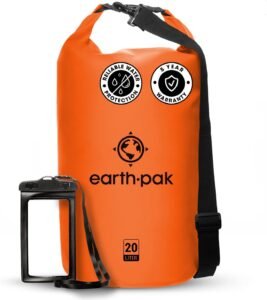
Dry Bags
This helps keep your gear dry and accessible, allowing you to relax and enjoy the journey without worrying about soaked belongings.
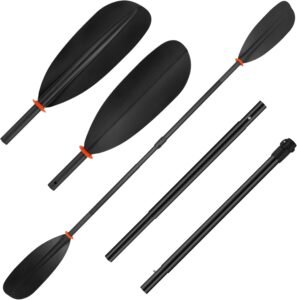
Kayak Paddles
Lightweight, ergonomic paddle designs reduce fatigue and strain on your wrists and shoulders, making your kayaking session a more enjoyable experience. You can also use paddle leashes, they help prevent you from losing your paddle in choppy waters.
Performance Enhancement Accessories
To truly master kayaking, you need to constantly improve your performance. The below will help in improving your mastery:
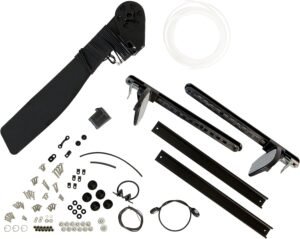
Paddle Grips
Rubber grips on your paddle shaft provide better handling, especially when your hands are wet.
Rudders and Skegs
These assist in tracking and maneuvering, particularly in windy or turbulent conditions.
Foot Pegs and Braces
These adjustable accessories allow you to brace your feet securely, improving balance and control.
Kayak Storage Accessories
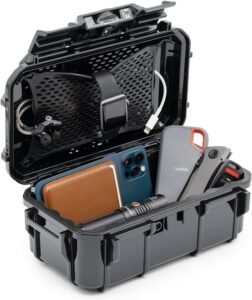
Dry Bags and Dry Boxes
Importance of Waterproof Storage
Waterproof storage is critical for kayakers to protect gear, phones, clothing, and valuables from getting wet. Here’s why it’s important:
- Gear Protection: Waterproof storage prevents water damage to essential equipment like cameras, electronics, and clothing.
- Buoyancy: Dry bags and boxes can provide additional buoyancy, which can be crucial in case of a capsize.
- Organization: They help you keep your gear organized and accessible, ensuring a smoother kayaking experience.
Different Types of Dry Bags and Their Sizes
- Roll-Top Dry Bags: These are the most common and come in a variety of sizes. They are sealed by rolling the top and clipping it shut, creating a waterproof seal.
- Duffel-Style Dry Bags: These have a wide mouth and are suitable for packing larger items or lots of gear.
- Compression Dry Bags: These are designed to compress your gear, saving space in your kayak.
- Zipper-Sealed Dry Bags: These are easy to access, as they have a zipper closure. They are great for items you need to reach quickly.
- Electronics Cases: Specifically designed for electronics like phones, cameras, and GPS devices, they offer extra protection against water and impacts.
The size of your dry bag depends on your storage needs and the size of your kayak. Smaller bags are ideal for personal items, while larger ones can accommodate bulkier gear or clothing.
Deck Bags and Hatch Covers
How Deck Bags and Hatch Covers Keep Gear Dry and Accessible
Deck bags and hatch covers are accessories that help keep your gear dry and easily accessible during your kayaking journey:
- Deck Bags: These are typically mounted on the deck of your kayak and provide convenient storage for items you want to keep within arm’s reach, like snacks, sunscreen, or a camera.
- Hatch Covers: Hatch covers seal the openings of compartments (hatches) in your kayak, ensuring that water doesn’t enter and damage your stored gear. They come in various sizes to fit different kayak models.
Recommendations for Different Kayak Types
When selecting deck bags and hatch covers, consider the type of kayak you have:
- Sit-On-Top Kayaks: Deck bags are suitable for sit-on-top kayaks, providing easily accessible storage.
- Sit-Inside Kayaks: Hatch covers are essential for sit-inside kayaks as they seal the hatches, keeping your gear dry and secure.
Ensure that the deck bags and hatch covers you choose are compatible with your kayak model and the gear you plan to carry.
Kayak Storage Racks
Benefits of Proper Kayak Storage
Proper kayak storage is essential for prolonging the life of your kayak and keeping it in good condition.
- Protection: Storing your kayak off the ground and away from the elements prevents damage from UV rays, moisture, and pests.
- Space Efficiency: Storage racks help maximize your storage space by keeping your kayak neatly organized.
- Easy Access: Wall mounts, freestanding racks, or ceiling hoists allow you to access your kayak easily whenever you’re ready to hit the water.
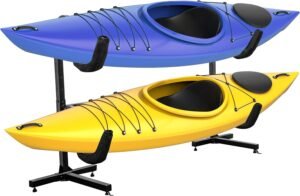
Wall Mounts, Freestanding Racks, and Ceiling Hoists
Different storage options are available to suit various storage spaces and preferences:
- Wall Mounts: Ideal for kayakers with limited floor space, wall mounts secure your kayak vertically against a wall.
- Freestanding Racks: These versatile racks can be placed indoors or outdoors, providing stability for your kayak and other gear.
- Ceiling Hoists: Ceiling hoists are great for garages or spaces with high ceilings. They allow you to suspend your kayak from the ceiling, freeing up floor space.
Navigation and Communication Accessories
Navigating waterways safely and staying connected with your fellow kayakers or rescue services are essential aspects of a successful kayaking adventure.
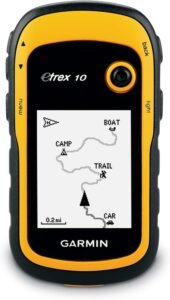
Kayak GPS and Navigation Tools
Global Positioning System (GPS) devices have become an indispensable tool for kayakers, offering several benefits:
- Precise Location Tracking: GPS units provide real-time information about your location, helping you stay on course and preventing you from getting lost.
- Waypoint Marking: You can mark important waypoints like launch sites, campsites, and points of interest, making it easier to plan and navigate your route.
- Mapping and Charting: Many GPS devices offer detailed maps and charts, allowing you to identify hazards, track currents, and plan safe routes.

VHF Radios
Very High Frequency (VHF) radios also happen to be one of the key accessories for on-water communication among kayakers and with emergency services.
- Marine Channel Communication: VHF radios allow kayakers to communicate on designated marine channels, ensuring clear and reliable communication within a group.
- Emergency Calls: In case of emergencies, VHF radios enable direct communication with the Coast Guard, search and rescue teams, and other vessels in the vicinity.
- Weather Updates: VHF radios provide access to weather updates, which are crucial for planning and staying informed about changing conditions.
What To Look For When Choosing A VHF Radio
When choosing a VHF radio for kayaking, consider the following recommendations:
- Floatability: Opt for a radio that is designed to float, so you can retrieve it if it falls in the water.
- Waterproofing: Ensure the radio has a high Ingress Protection (IP) rating for water resistance, as it will likely be exposed to splashes and rain.
- Battery Life: Look for radios with long battery life, especially if you plan on extended trips. Consider models with rechargeable batteries for convenience.
- DSC (Digital Selective Calling): This feature allows you to send an emergency distress signal with your precise location, greatly enhancing safety.
- Compact and Lightweight: Kayakers should choose radios that are compact and lightweight for easy portability.
Kayak Fishing Accessories
If you’re an angler who enjoys combining the tranquility of kayaking with the excitement of fishing, there are several essential fishing accessories that can enhance your experience.
Fishing Rod Holders
Various Types of Rod Holders for Angling Kayaks
Fishing rod holders are essential for kayak anglers as they free up your hands while keeping your fishing rods secure. Here are some common types:
- Flush-Mount Rod Holders: These are installed directly into the kayak, usually on the gunwales or deck. They provide a clean, low-profile look and are ideal for trolling.
- Scotty-Type Rod Holders: These are adjustable and can be mounted on specialized kayak mounts or gear tracks. They offer versatility in rod placement and angle.
- Clamp-On Rod Holders: These can be clamped onto the kayak’s rails or other suitable locations, making them easily transferable between kayaks.
- Rocket Launchers: These hold multiple rods at once and are often mounted on the kayak’s rear. They are excellent for trolling or carrying multiple rods for various techniques.
Placement and Functionality
The placement of your rod holders is crucial for efficient and comfortable fishing:
- Behind the Seat: Installing rod holders behind your seat allows for easy access while maintaining a comfortable fishing position.
- On the Gunwales: Gunwale-mounted holders are ideal for trolling or storing additional rods within arm’s reach.
- On the Front Deck: Some anglers prefer to have rod holders on the front deck for quick access to their rods.
- Adjustable Angle: Many rod holders can be adjusted to different angles, allowing you to adapt to various fishing styles, such as trolling or casting.
The right combination of rod holders can accommodate your preferred fishing techniques, whether it’s trolling, casting, or jigging, and ensure your gear is readily accessible.
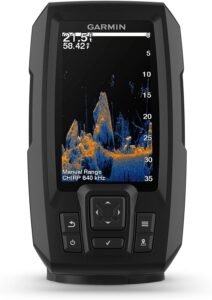
Fishfinders and Depth Finders
Fishfinders and depth finders utilize sonar technology to help anglers locate fish and understand the underwater environment:
- Sonar Transducer: The transducer sends out sound waves that bounce off objects underwater. By measuring the time it takes for the sound waves to return, the device creates a detailed image of the underwater terrain and any fish present.
- Fish Identification: Advanced fishfinders can differentiate between fish and other underwater structures, helping anglers target their desired catch.
- Depth Measurement: These devices provide real-time depth information, crucial for finding fish at different water depths.
What To Look For When Selecting A Fishfinder or Depthfinder
When selecting a fishfinder for kayaking, consider the following factors:
- Portability: Choose a compact and lightweight fish finder that’s easy to mount on your kayak.
- Battery Life: Opt for a model with a long-lasting battery, especially if you plan to spend extended periods on the water.
- Display: Ensure the display is easy to read in various lighting conditions, including direct sunlight.
- Transducer Placement: Pay attention to how and where the transducer can be mounted on your kayak.
- GPS Integration: Some fishfinders come with built-in GPS, which can be useful for marking fishing spots and navigating.
- Durability: Given the potential exposure to water and sun, choose a fishfinder that is designed to withstand these conditions.
Kayak Transportation Accessories
Transporting your kayak safely to and from the water is a critical aspect of kayaking.
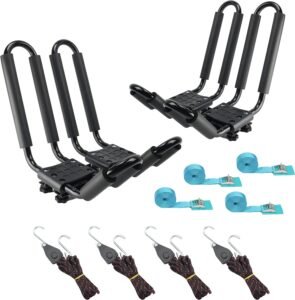
Kayak Carriers and Roof Racks
Transporting kayaks on vehicles can be accomplished using different methods:
- Roof Racks: Roof racks are the most common and versatile option. They consist of crossbars that are attached to the roof of your vehicle and provide a platform for securing your kayak.
- Kayak Carriers: These specialized accessories are designed to hold and secure kayaks on your roof racks. They come in various styles, including J-cradles, saddles, and stackers, each suited to different kayak shapes and sizes.
- Trailer: If you frequently transport multiple kayaks or have limited roof space, a kayak trailer may be a practical solution.
- Bed Extender: Pickup truck owners can use a bed extender to safely transport kayaks in the truck bed.
What To Look For When Selecting A Roof Rack/Carrier
When selecting roof racks and carriers, consider the following recommendations:
- Compatibility: Ensure that the roof racks and carriers you choose are compatible with your vehicle and kayak type. Some racks may require specific adapters or modifications.
- Quality and Durability: Invest in high-quality racks and carriers made from durable materials to ensure long-lasting performance.
- Ease of Use: Look for racks and carriers that are easy to install and load. Quick-release mechanisms can save you time and effort.
- Security: Consider racks and carriers that come with locks or can be easily secured to deter theft.
- Padding: Roof racks with built-in padding or accessories like foam blocks can protect your kayak during transportation.
Steps for Safely Loading and Securing a Kayak on Your Transportation Medium
Loading and securing a kayak properly is essential for safe transportation:
- Prepare the Roof Rack: Ensure that your roof rack is set up correctly and the crossbars are spaced to accommodate your kayak.
- Use Padding: Place padding on the roof rack crossbars to protect the kayak’s hull.
- Position the Kayak: Lift the kayak and position it on the roof rack with the cockpit facing up. Center it on the crossbars, leaving an equal amount of overhang on both sides.
- Strap the Kayak: Use kayak straps to secure the kayak to the roof rack. Start by threading the straps underneath the crossbars and over the kayak’s hull.
- Tighten Straps: Pull the straps snugly but not overly tight to avoid damaging the kayak. Ensure that the kayak is firmly secured to the roof rack.
- Use Bow and Stern Lines: Attach bow and stern lines to the kayak’s front and rear handles. These lines help prevent the kayak from shifting during transportation and provide additional security.
- Double-Check: Before driving, double-check that all straps and lines are secure and that the kayak is firmly in place.
Use of Straps, Bow and Stern Lines, and Padding
- Straps: Use high-quality kayak straps with cam buckles or ratchets. Ensure that the straps are in good condition and free from fraying or damage.
- Bow and Stern Lines: These lines help prevent the kayak from lifting off the roof rack during wind gusts or sudden stops. Attach them securely to the front and rear handles of the kayak and anchor them to suitable points on your vehicle, such as tow hooks or the trailer hitch.
- Padding: Roof rack padding or foam blocks provide cushioning and protection to the kayak’s hull during transportation. They reduce the risk of scratches or damage.
Kayak Repair and Maintenance Accessories
Maintaining your kayak and having the means to address unexpected issues is crucial for ensuring your safety and the longevity of your equipment.
Kayak Repair Kits
A kayak repair kit is your lifeline when things go awry on the water. Here’s why every kayaker should carry one:
- Emergency Repairs: Accidents happen, and damage to your kayak or gear can occur unexpectedly. A repair kit enables you to address minor issues on the spot, preventing them from becoming major problems.
- Safety: A well-maintained kayak is a safe kayak. Having the tools to fix equipment failures, such as a cracked hull or a leaking seam, ensures you can continue your journey safely.
- Self-Sufficiency: A repair kit promotes self-sufficiency. Instead of relying on outside help or rescue services, you can take control of the situation and keep your adventure on track.
Essential Items to Include in a Repair Kit
- Duct Tape: Versatile and quick to apply, duct tape can temporarily patch minor hull damage or fix gear.
- Marine Epoxy: Ideal for permanent repairs to the kayak hull, especially for cracks or punctures.
- PVC or Nylon Patch Material: These patches can be used to repair tears or holes in the kayak’s skin or fabric components.
- Spare Parts: Carry spare parts like bungee cords, buckles, and clips, which are prone to wear and tear.
- Spare Paddle: A collapsible or breakdown paddle can be a lifesaver if your primary paddle breaks.
- Multi-Tool or Knife: Useful for cutting materials, making adjustments, or freeing jammed parts.
- Screwdriver or Allen Wrench Set: For tightening or replacing hardware as needed.
- Rescue Tape: A self-fusing silicone tape that can seal leaks and provide a temporary fix for various issues.
- Float Bags or Inflatable Bladders: These can be used to provide buoyancy in case of hull damage or a flooded cockpit.
- Whistle: A signaling device can be crucial in emergencies.
Useful Tips on Cleaning and Maintaining Your Kayak and Accessories
Regular cleaning and maintenance are essential for the long-term health of your kayak and gear:
- Rinse After Use: After each paddling session, rinse your kayak with fresh water to remove salt, sand, or debris that can cause corrosion and damage.
- Store Properly: Store your kayak indoors, if possible, to protect it from UV rays and the elements. Use a kayak cover to shield it from dust and dirt.
- Inspect Gear: Regularly inspect your gear, including PFDs, paddles, and safety equipment, for signs of wear or damage. Replace any compromised items.
- Lubricate Moving Parts: Lubricate hinges, ratchets, and moving parts to prevent corrosion and ensure smooth operation.
- Check Hatch Seals: Inspect hatch seals for wear or damage and replace them if necessary to maintain a watertight compartment.
Importance of Regular Inspections
- Hull Inspection: Check your kayak’s hull for cracks, punctures, or other damage. Address any issues promptly to prevent water infiltration.
- Deck and Rigging: Inspect deck lines, bungee cords, and rigging for wear and replace or repair as needed.
- Seats and Padding: Check the condition of your kayak seat and padding to ensure they provide the necessary support and comfort.
- Hardware: Examine all hardware, such as hatches, handles, and rudders, to ensure they are secure and functioning correctly.
- Foot Pegs and Braces: Inspect foot pegs and braces for proper adjustment and functionality.
Custom Kayaking Accessories and Tips
Personalizing and customizing your kayak is not only a fun aspect of the sport but also an opportunity to enhance its functionality and aesthetics.
Customizing Your Kayak
Personalizing your kayak allows you to make it uniquely yours and tailor it to your specific needs and preferences. Here are some ways you can customize your kayak:
- Kayak Graphics and Decals: Add flair to your kayak with custom graphics and decals. These can include your name, favorite designs, or patterns to make your kayak stand out.
- Color and Paint: Some kayakers choose to repaint their kayaks or add colored accents to match their personal style or make their kayak more visible on the water.
- Accessories: Customize your kayak’s functionality by adding accessories like rod holders, cup holders, or GPS mounts to suit your needs.
- Comfort Upgrades: Invest in comfortable seat cushions, backrests, or padded footrests to enhance your comfort during long paddling sessions.
- Storage Solutions: Personalize your kayak with additional storage options like mesh pockets, gear bags, or crate systems to keep your essentials organized.
- Safety Gear: Customize your safety setup by adding items like a kayak flag, whistle, or emergency strobe light for added visibility and safety.
The right accessories can make all the difference between a good time on the water and an unforgettable adventure. From safety essentials to comfort upgrades and customization options, kayaking accessories play a key role in enhancing your experience. Invest in the right kayak accessories.




